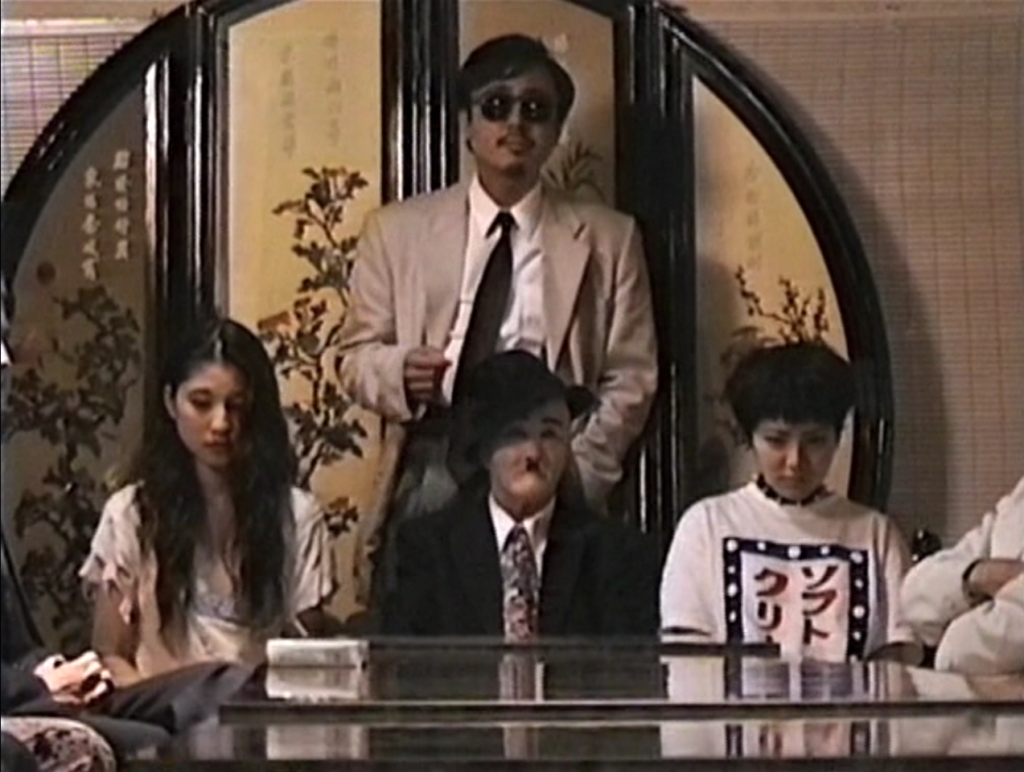Despite its 2012 release, Bad Film captures a Sion Sono before he reached international acclaim; before his particular brand of otaku-influenced action films; and before his unabashed revelry in exhibitionism and voyeurism. It was filmed back in the mid-’90s, way before Sono’s breakout Suicide Club, and not finished until after his critical success Love Exposure, in 2011. This allowed a wizened Sono to collect fragments (roughly 150 hours) of his earlier activist years and turn them into either a diary of a particular time in Tokyo or a larger message about how he views his youth in retrospect. That time rift allows a nice selling point for a film that has been relatively underrepresented in Sono’s catalogue, but Bad Film‘s use of nostalgic reflection elevates it beyond mere curiosity.
Shooting primarily in his home of Tokyo’s Kōenji district (neighboring Shinjuku, which contains the yakuza-controlled Kabukichō district), Sono enlisted the 2,000 members of his performance art collective Tokyo GAGAGA to form a rough narrative about gang life, nativism, homophobia, and, most importantly, love. A Sinophobic Japanese gang meets and disparages a Chinese gang on the busy Chūō-Sōbu train line, leading to a Montague/Capulet-style turf war, complete with a lesbian Romeo and Juliet romance. But though Bad Film could easily stand a Shakespearean reading, Sono further complicates the narrative by having the gay members of each gang form their own cheaper black market for weapons, leading to a complete dissolution of their structure, with no one left to trust.
Bad Film‘s fictional elements could point to Masao Adachi’s and Koji Wakamatsu’s political films of the ’60s and ’70s, but its real power comes as a historical document of protest and revolution through art.
Of course, orgy-prone, violent gang narratives like Bad Film‘s fit rather comfortably for Sono, so what becomes most interesting here is just the act of trying to keep up with the damn thing. Shot on as many cheap Hi8 video recorders as GAGAGA could afford, the film jumps from camera to camera to camera (each used by actors in the film), as if already taking part in a Snapchat culture, recording every moment from every perspective. The film switches between a chaotic mélange of footage for the more violent scenes, settling down when it finds something beautiful (usually in the middle of a rape or death sequence). There’s even a ten minute-long shot that just documents a Japanese boss slapping every gang member in the room. Curiously, Sono never chooses to hide his cinematographers; it’s relatively easy to spot a few punks with cameras in each scene. This is likely due to the fact that it would be impossible to block out every cameraperson in a shot that includes hundreds of protesters (illegally shot as part of real GAGAGA demonstrations). Sono also explains this by literally interrupting the narrative and pointing out that these cameras are a way for the Japanese boss to masochistically document his group’s violence. That bit of dialogue finds an older Sono apologizing for the hasty young director, while still owning up to his politics, formal decisions, and collaborators.
The end credits of Bad Film only credit Tokyo GAGAGA. There could be nothing more fitting: This is a document of Sono’s collaborative nature and his years of being embedded in political strife and performance art culture. Its fictional elements point to Masao Adachi’s and Koji Wakamatsu’s political films of the ’60s and ’70s, but its real power comes as a historical document of protest and revolution through art—something that would be emulated in the west with the artistic output of the Occupy movement. Sono occupies the center of his film, donning sunglasses and a megaphone in the middle of Kōenji, shouting “GAGAGA!” at the top of his lungs. He didn’t just create these characters, their stories, the locations, and messages—he was there living them, and he was one of many.
This film has yet to be theatrically released in the U.S.


Comments are closed.